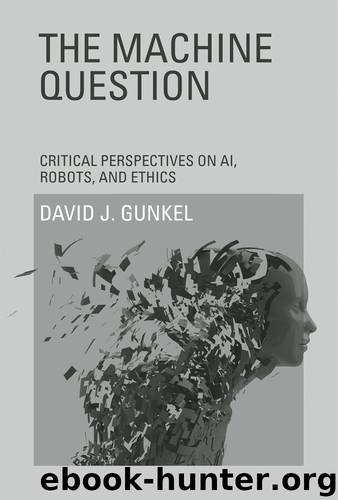The Machine Question by David J. Gunkel

Author:David J. Gunkel [Gunkel, David]
Language: eng
Format: epub
ISBN: 9780262304511
Publisher: The MIT Press
Published: 2012-06-10T16:00:00+00:00
2.4 Information Ethics
One of the criticisms of animal rights philosophy is that this moral innovation, for all its promise to intervene in the anthropocentric tradition, remains an exclusive and exclusionary practice. “If dominant forms of ethical theory,” Calarco (2008, 126) concludes, “—from Kantianism to care ethics to moral rights theory—are unwilling to make a place for animals within their scope of consideration, it is clear that emerging theories of ethics that are more open and expansive with regard to animals are able to develop their positions only by making other, equally serious kinds of exclusions.” Environmental and land ethics, for instance, have been critical of Singer’s “animal liberation” and animal rights philosophy for including some sentient creatures in the community of moral patients while simultaneously excluding other kinds of animals, plants, and the other entities that make up the natural environment (Sagoff 1984). In response to this exclusivity, environmental ethicists have, following the precedent and protocols of previous liberation efforts like animal rights philosophy, argued for a further expansion of the moral community to include these marginalized others. “The land ethic,” Aldo Leopold (1966, 239) wrote, “simply enlarges the boundaries of the community to include soils, waters, plants, and animals, or collectively, the land.” Such an ethics makes a case for extending moral and even legal “rights to forests, oceans, rivers, and other so-called ‘natural objects’” (Stone 1974, 9). Or as Paul W. Taylor (1986, 3) explains, “environmental ethics is concerned with the moral relations that hold between humans and the natural world. The ethical principles governing those relations determine our duties, obligations, and responsibilities with regard to the Earth’s natural environment and all the animals and plants that inhabit it.”
Although this effort effectively expands the community of legitimate moral patients to include those others who had been previously left out, environmental ethics has also (and not surprisingly) been criticized for instituting additional omissions. In particular, the effort has been cited for privileging “natural objects” (Stone 1974, 9) and the “natural world” (Taylor 1986, 3) to the exclusion of nonnatural artifacts, like artworks, architecture, technology, machines, and the like (Floridi 1999, 43). This exemption is evident by the fact that these other entities typically are not given any explicit consideration whatsoever. That is, they are literally absent from the material of the text, as is the case with Leopold’s writing on the land ethic, which says nothing about the place of nonnatural artifacts. Or it is explicitly identified, explained, and even justified, as is the case with Taylor’s Respect for Nature, which argues, by way of mobilizing the standard anthropological and instrumental theories, that machines do not have “a good of their own” that would need to be respected:
The ends and purposes of machines are built into them by their human creators. It is the original purposes of humans that determine the structures and hence the teleological functions of those machines. Although they manifest goal-directed activities, the machines do not, as independent entities, have a good of their own.
Download
This site does not store any files on its server. We only index and link to content provided by other sites. Please contact the content providers to delete copyright contents if any and email us, we'll remove relevant links or contents immediately.
Whiskies Galore by Ian Buxton(40305)
Introduction to Aircraft Design (Cambridge Aerospace Series) by John P. Fielding(32332)
Small Unmanned Fixed-wing Aircraft Design by Andrew J. Keane Andras Sobester James P. Scanlan & András Sóbester & James P. Scanlan(32137)
Craft Beer for the Homebrewer by Michael Agnew(17440)
Turbulence by E. J. Noyes(7033)
The Complete Stick Figure Physics Tutorials by Allen Sarah(6632)
Kaplan MCAT General Chemistry Review by Kaplan(6045)
The Thirst by Nesbo Jo(5779)
Bad Blood by John Carreyrou(5763)
Learning SQL by Alan Beaulieu(5400)
Weapons of Math Destruction by Cathy O'Neil(5032)
Man-made Catastrophes and Risk Information Concealment by Dmitry Chernov & Didier Sornette(4731)
iGen by Jean M. Twenge(4695)
Digital Minimalism by Cal Newport;(4512)
Life 3.0: Being Human in the Age of Artificial Intelligence by Tegmark Max(4497)
Audition by Ryu Murakami(4093)
1,001 ASVAB Practice Questions For Dummies by Powers Rod(4034)
Electronic Devices & Circuits by Jacob Millman & Christos C. Halkias(4021)
Pale Blue Dot by Carl Sagan(3997)
